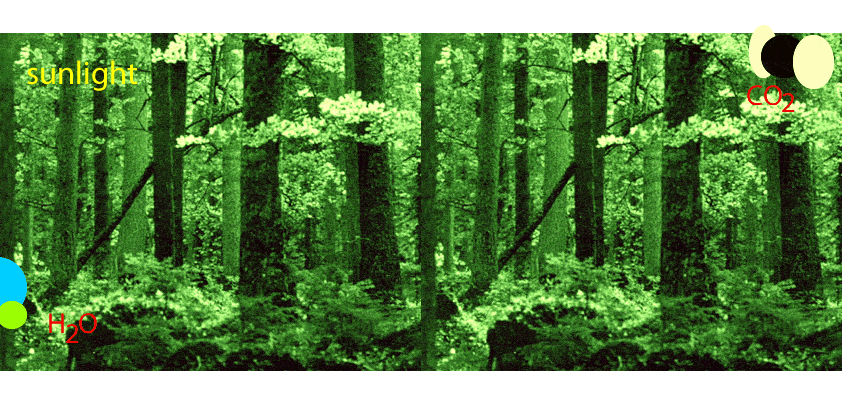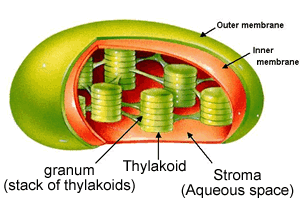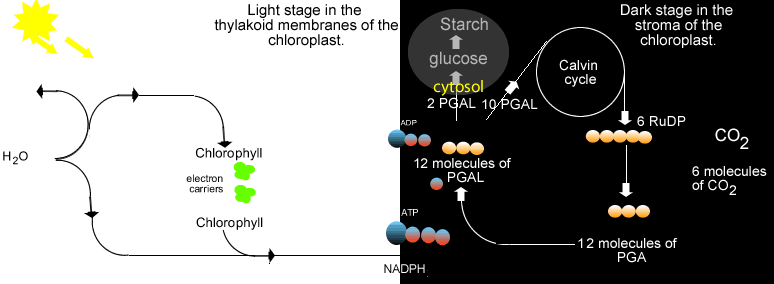

Photosynthesis occurs in the chloroplast. The chloroplast is not just a simple vesicle containing chlorophyll but a highly specialised organelle with a complex internal structure, as shown on the right. (source Google). It is a membrane bound organelle that contains, apart from the photosynthetic machinery, its own ribosomes, DNA, and starch granules.


Click for a simple explanation of the Calvin Cycle
A few things we should note form observing the animation.
- The process of photosynthesis occurs in two stages, the light dependent (light) and light independent (dark) stages. It is important to appreciate that both stages go on simultaneously, that's assuming that light is provided.
The Light stage
- The light stage takes place in the thylakoid membranes of the chloroplast while the dark stage takes place in the stroma of the chloroplast.
-The function of the light stage is twofold:
---- a) the splitting of water to provide protons (H+) for the reduction of carbon dioxide. These protons are carried by a special carrier molecule known as NADP (nicotinamide adenine dinucleotide phosphate). It is during this stage that oxygen is released as a byproduct. The oxygen produced during photosynthesis comes from the water molecule .during the light stage;
---- b) the formation of ATP. Light energy is absorbed by chlorophyll and causes an electron to become excited. This electron leaves the chlorophyll molecule and is passed along special molecules where its energy is used to convert ADP into ATP. This ATP is used as an energy source for the formation of carbohydrate in the dark stage.
Click to see a narrated video on the light dependent stage.
Video source unknown - this video was not produced by the author
View the animation of the right of the light dependent stage.
Where does the oxygen, given off during photosynthesis, come from?
The light dependent stage produces
The energy required for ATP synthase to function comes from
Oxygen gas is formed in the
Ultimately the energy in the molecule of ATP has come from the
Video source unknown - this video was not produced by the author
The Dark Stage
- The chain of reactions that take place, in the dark stage, to produce carbohydrates are cyclical and combined are known as the Calvin Cycle. The Calvin cycle utilizes light energy stored as ATP and NADPH to convert CO2 and H2O to organic compounds.
The Calvin Cycle can be summerised by the equation below.
6 CO2 + 12 NADPH + 12 H+ + 18 ATP → C6H12O6 + 6 H2O + 12 NADP+ + 18 ADP + 18 Pi
This takes place in the stroma of the chloroplast to produce a molecule called phosphoglyceraldehyde (PGAL). This molecule moves out from the chloroplast and into the cytosol where 2 PGAL molecules are converted into glucose;
- Carbon dioxide is reduced to form carbohydrates in endergonic, energy requiring, reactions only in the dark stage;
- Molecules such as NADP are recycled as are the molecules ADP and inorganic phosphate (Pi)
Look at the video on the right on the Calvin Cycle. Answer the questions below.
1) The dark stage of photosynthesis or light independent stage takes place in total darkness.
2) What two high energy molecules, produced in the light dependent stage, power the Calvin Cycle.
3) Molecules that are recycled between the dark and light stages are
4) The Calvin Cycle takes place in the
5) The starting compound of the Calvin Cycle is a 5 carbon compound called RuBP
6) Water is added to each RuBP molecule during the Calvin Cycle
7) PGAL is a 3 carbon molecule that exits the Calvin Cycle every turn.
8) Three new molecules of 5 carbon RuBP are created from carbon dioxide at the start of every cycle.
9) A 6 carbon glucose molecule is synthesised from 2 three carbon PGAL molecules in the
Video source unknown - this video was not produced by the author